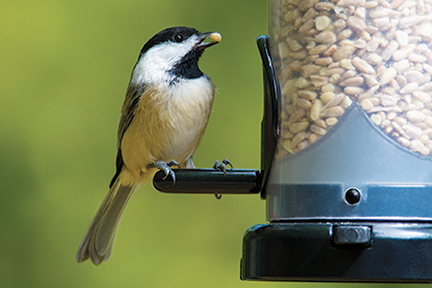The Toughest Birds at Your Feeders: Woodpeckers
Woodpeckers are built for impact. When excavating, they can strike wood at roughly 13–15 mph and deliver over a hundred blows per minute. Thanks to specialized anatomy, they thrive where most birds could not.
Adaptations That Make Woodpeckers Tough
- Shock management: The skull is reinforced with spongy, air-filled bone, and the bones between the bill and skull are joined by flexible cartilage that helps absorb shock. The head and body align straight on impact, and strong neck muscles redirect shear forces away from the brain.
- Self-renewing bill: Special cells at the bill tip continually replace worn material, keeping the chisel edge sharp.
- Tail as a prop: Extra-stiff, pointed tail feathers; enlarged tail bones and vertebrae; and powerful support muscles let the tail brace the bird’s weight while climbing and drilling.
- Precision foraging tools: A long, barbed, highly sensitive tongue—often 2–3× bill length—can detect and spear larvae. Sticky mucus from large salivary glands helps secure prey. Tufts of feathers over the nostrils and a protective third eyelid keep debris out.
- Climbing grip: Zygodactyl feet (two toes forward, two back) provide superior hold on trunks and branches.
- Camouflage: High-contrast black-and-white back patterns (“disruptive coloration”) help break up their outline on bark.
What They Eat & How to Attract Them
Offer suet, no-melt dough, and blends with nuts to draw woodpeckers in. A WBU Tail Prop feeder supports their bracing behavior and provides a comfortable, natural feeding posture. Leaving safe dead snags where practical adds foraging and nesting options.
Species Notes
Downy Woodpecker
- Smallest North American woodpecker (~6").
- Differentiator vs. Hairy: very short bill (about the width of the head); head appears twice as wide as bill.
- Eats at least 40+ insect types; pecks deeper in winter and prefers rough-barked trees that hold overwintering insects.
- May forage with chickadees, titmice, nuthatches, and Hairy Woodpeckers, using their alarm calls for predator awareness.
Hairy Woodpecker
- Chisel-like bill much longer than Downy’s; larger overall.
- Diet includes beetle larvae and ants; occasionally drinks sap from sapsucker wells and even from hummingbird feeders.
Red-bellied Woodpecker
- Omnivorous: insects, fruits, and occasionally small vertebrates or eggs.
Northern Flicker
- Ground-foraging specialist; spends much of its time on ants and other ground insects.
- Often roosts on vertical surfaces rather than inside cavities.
Pileated Woodpecker
- Second-largest woodpecker in North America; dramatic, rectangular excavations in dead wood.
Sapsuckers
- Drill orderly sap wells—sometimes dozens per hour. They lap sap with brush-tipped tongues and feed on insects attracted to the sap.
Longevity Records (banding)
- Downy — 11 years, 11 months
- Hairy — 15 years, 11 months
- Pileated — 12 years, 11 months
- Red-headed — 9 years, 11 months
- Red-bellied — 12 years, 1 month
- Northern Flicker — 9 years, 2 months

